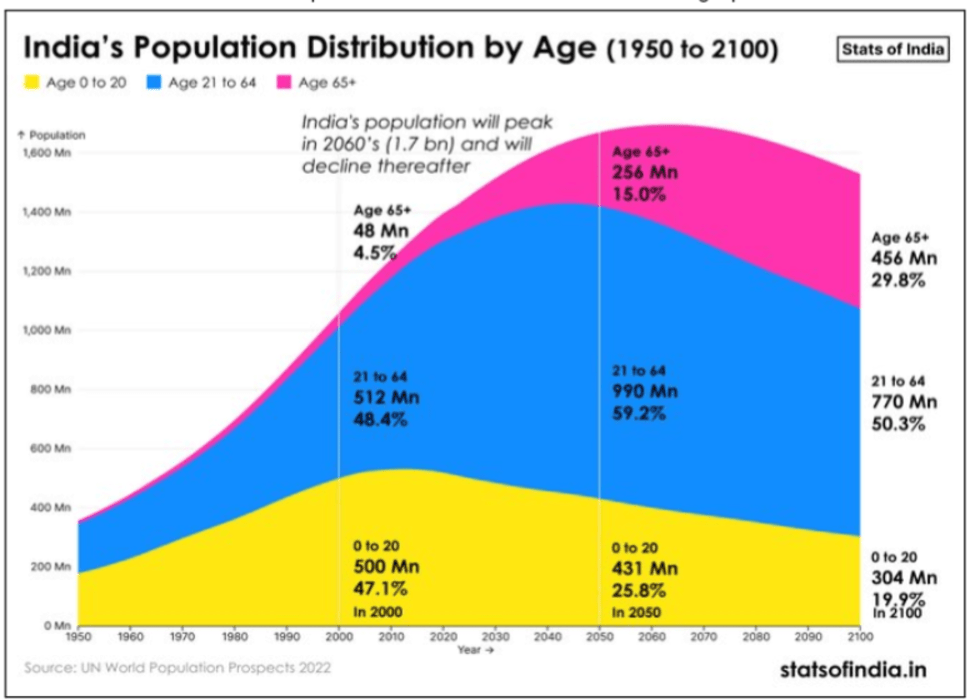India’s demographic journey of hits and misses
News Excerpts:
From averting a looming demographic crisis to working towards achieving the Sustainable Development Goals by 2030, there are numerous aspects worth examining in the country.
More About the News:
- On July 11, as we mark World Population Day, there is ample reason to reflect on India's demographic evolution across the decades.
- The United Nations designated this day in 1989 following the proposal by Dr. K.C. Zachariah, a distinguished demographer.
- At that time, the global population had surpassed five billion in 1987, bringing to the forefront issues like poverty, healthcare, and gender inequality, especially prevalent in developing nations.
World Population Day:
The 1960s and 1970s saw global population growth alarming at a 2% annual rate, prompting dire predictions for India including widespread poverty, hunger, and mortality. Contrary to these forecasts, subsequent decades unfolded a different narrative.
- Fertility Rates: Global fertility rates plummeted due to improved living conditions and healthcare, boosting life expectancy. Similarly, India witnessed a decline in fertility rates since the 1970s, now below replacement levels.
- Remarkable strides have been made in health indicators, notably reducing maternal and child mortality.
- SDGs: The UN's adoption of the Sustainable Development Goals (SDGs) in 2015 underscored global progress benchmarks, with 2030 as a pivotal target year.
- India's advancements in SDGs must be assessed in light of its evolving demographic landscape.
India’s population dynamics:
India's demographic landscape is shaped significantly by three key components: fertility, mortality, and migration.
- Fertility: India has achieved significant success in reducing fertility rates.
- The National Family Health Survey (NFHS)-5 shows a drop in the total fertility rate (TFR) from 3.4 in 1992 to 2 in 2021, falling below the replacement level of 2.1.
- This shift towards smaller family sizes implies a decrease in the dependent population and a potential demographic dividend, where the working-age population outnumbers dependents.
- Mortality: There has been a notable decline in mortality rates, coupled with an increase in life expectancy.
- This demographic shift indicates an ageing population, with individuals aged 60 years and above making up 8.6% of the total population in 2011—a figure projected to reach 19.5% by 2050.
- Improved healthcare and living standards have been instrumental in this transition.
- Migration and Urbanization: Rapid rural-to-urban migration presents complex challenges, particularly in terms of urban infrastructure strain. Migration patterns also influence the demographic composition, with significant implications for urban planning and resource allocation.
- By addressing these multifaceted challenges, India can chart a path towards inclusive and sustainable development that embraces its diverse demographic realities.

The country’s SDG journey:
Development can be simplified as ensuring that everyone has access to basic necessities like food, shelter, and healthcare. 'No Poverty, Zero Hunger, and Good Health' represent the fundamental Sustainable Development Goals (SDGs) that are essential for achieving development.
- Significant Strides in Reducing Poverty: India's journey from facing demographic challenges to striving towards the 2030 goal of 'leaving no one behind' has seen both successes and setbacks.
- The proportion of the population below the poverty line dropped from 48% to 10% between 1990 and 2019.
- Key initiatives contributing to this success include: Mahatma Gandhi National Rural Employment Guarantee Act (MGNREGA; came into effect in 2006), Janani Suraksha Yojana (2005).
- Achievements in Food Security: Concerns about India's ability to feed its population were raised in Paul R. Ehrlich's controversial book 'The Population Bomb' (1968).
- However, the Green Revolution enabled India to achieve self-sufficiency in crop production and mitigate hunger.
- While the proportion of people suffering from hunger decreased from 18.3% in 2001 to 16.6% in 2021, malnutrition remains a significant issue, with India bearing a third of the global burden.
- Though the Indian government launched the Prime Minister’s Overarching Scheme for Holistic Nourishment (POSHAN) Abhiyaan in 2018, it will still require a miracle to fulfill the target of ‘Zero Hunger’ by 2030.
- Progress in Healthcare: Healthcare in India has shown remarkable progress, evidenced by declines in critical mortality indicators: Maternal Mortality Rate (MMR), Under-five Mortality Rate, Infant Mortality Rate.
- The Maternal Mortality Rate (MMR) decreased from 384.4 in 2000 to 102.7 in 2020.
- The mortality rate for children under five reduced significantly post 2000s.
- The infant mortality rate also reduced from 66.7 deaths per 1,000 live births in 2000 to 25.5 deaths per 1,000 live births in 2021.
- Despite these achievements, challenges persist in achieving SDG targets, particularly regarding equitable distribution of development benefits and addressing health disparities.
- The concentration of wealth among the top 10% of the population, as highlighted by Oxfam, underscores the need for inclusive growth.
|
What needs looking into:
To achieve the SDGs, India must recognize and respond to its evolving population dynamics when formulating policies. Addressing income inequality, leveraging the demographic dividend through youth employment opportunities, and adapting to changing health needs are essential steps.
- Non-communicable diseases (NCDs), which impose significant financial burdens on families, underscore the need for robust safety nets to prevent families from falling into poverty.
- Improving nutrition outcomes requires strengthening existing programs, which necessitates increased budget allocations for health and nutrition sectors.
- Additionally, promoting gender equality and empowering vulnerable women are pivotal for addressing various challenges and advancing India's progress towards the SDGs.
- These measures collectively contribute to a comprehensive approach to sustainable development in India.
Conclusion: India faces a substantial journey ahead to achieve all SDG targets, necessitating collaboration across multiple sectors and strong political commitment. The country's advancement in SDGs is closely tied to the welfare of its population, and effective progress hinges on a deep understanding of population dynamics and proactive issue resolution.


